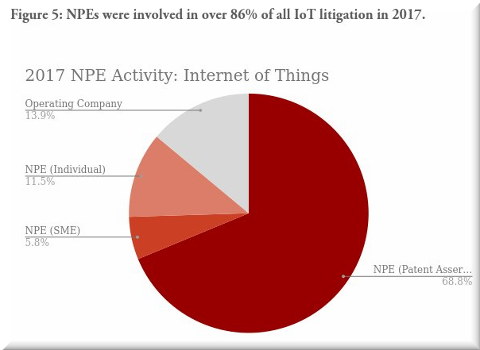This is not innovation but parasitic taxation

Summary: Some complete/exhaustive statistics (not interpolated/extrapolated but limited to one area) from Unified Patents help demonstrate trends in patent litigation in the United States; it's clear that much work remains to be done by patent reformers
EVEN though it's Easter (so we've been writing less) the
USPTO continues granting patents and lawsuits continue to be filed. On Wednesday/Thursday, for example, Unified Patents
showed that patent litigation is dominated by patent trolls, at least when it comes to software patents 'dressed up' as "Internet of Things". There are plenty of figures in this analysis and we have reproduced only one (above) under Fair Use.
From the outline:
From 2012 to 2017, NPE litigation activity for Internet of Things (IoT) technologies remained consistently high (between 85% and 98% of all IoT litigation). After reaching a record number of new IoT litigations in 2016, new filings in 2017 returned to pre-2016 levels. While litigation involving most IoT technologies either decreased or saw marginal increases in 2017, the proporation of IoT litigation over Communication Protocols & Networking increased from 3% (2016) to 44% (2017).
Unified Patents' Robert Jain later (yesterday)
added: "Whatever the cause, the volume of NPE-related filings [troll lawsuits] remains high as is seen in the figures below."
Patent litigation in Q1 2018 held steady with the number of new filings slightly exceeding the volume of cases seen in the second half of 2017. In recent years, the number of new filings has been highest in the first and second quarters which may indicate we will see fewer patent litigations in 2018. However, the uncertainty surrounding upcoming changes in patent law, such as the pending Oil States decision, may be in part responsible for these lower filing rates. Whatever the cause, the volume of NPE-related filings remains high as is seen in the figures below.
In relative terms, patent trolls are still a major problem. Sure, the overall number of patent lawsuits nosedived, but that did little to tackle patent trolls
specifically and a lot of their nefarious activity goes on not inside the courtroom but outside the legal system. They bully and eventually extort companies, otherwise that ends up with lawsuits.
We are far from done reforming things; the software community should not assume that 35 U.S.C. ۤ101 changes have fixed everything. Much of the blackmail is extrajudicial in nature, which means that the views/interpretations of courts/PTAB never get factored in (or into calculations associated with the harm done by trolls).
⬆

